For signal lower than 5V use high speed comperator: eBay
TFT 6MHz FREQUENCY COUNTER NANO ATtiny88
Counter using Low cost Arduino NANO with ATtiny88. The LCD TFT module is a 1.8" 128x160 pixel and has the driver ST7735
The frequency is displayed by 7 digits with leading zeros removed down to 3 digits. The picture displayed is based on universal text. The period is calculated. When input frequency is less than 1000Hz the period is displayed in us.
The counting is over a period of 1 second, generated by the 16 MHz crystal oscillator. The max counting is 7 digits
(6MHz) with resolution of 1Hz. Period of 1 sec is generated by TMR1, TIMER0 is the counter.
ATttiny is programmed using Arduino IDE. Use these instructions https://handsontec.com/dataspecs/module/Arduino/Arduino%20Tiny%2088.pdf
 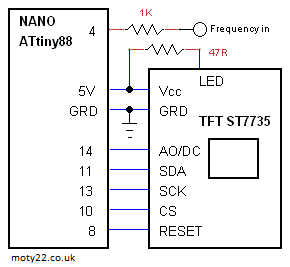 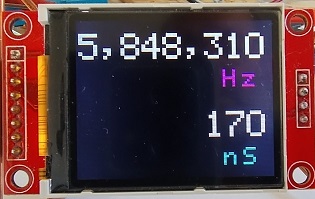

TFT 16MHz FREQUENCY COUNTER PIC16F1827
LCD TFT is digital display at its best, it displays versatile clear picture. The picture is built by entering the address and the color of a pixel or rectangle, so it's simple to use too.
Counter using PIC16F1827 drives the TFT SPI.
Included C code and circuit diagram. The LCD TFT module is a 1.8" 128x160 pixel and has the driver ST7735
The frequency is displayed by 7 digits with leading zeros removed down to 3 digits. The picture displayed is based on universal text. The period is calculated. When input frequency is less than 1000Hz the period is displayed in us.
The counting is over a period of 1 second, generated by the 8 MHz crystal oscillator increased to 32MHz by the internal PLL. The max counting is 8 digits
(16MHz) with resolution of 1Hz for frequencies below 2MHz. Period of 1 sec is generated by TMR1 and CCP1.
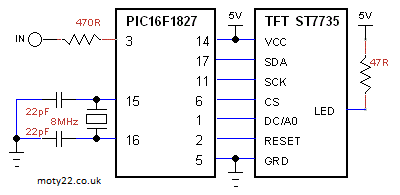 

TFT 16MHz FREQUENCY COUNTER PIC16F628A
LCD TFT is digital display at its best, it displays versatile clear picture. The picture is built by entering the address and the color of a pixel or rectangle, so it's simple to use too.
Counter using PIC16F628A drives the TFT with software SPI (slower SPI).
The LCD TFT module is a 1.8" 128x160 pixel and has the driver ST7735
The frequency is displayed by 8 digits with leading zeros removed down to 3 digits. The picture displayed is based on universal text. The period is calculated. When input frequency is less than 1000Hz the period is displayed in us.
The counting is over a period of 1 second, generated by the 16 MHz crystal oscillator. The max counting is 8 digits
(16MHz). Period of 1 sec is generated by TMR1 and CCP1.
Code is for MPLABX v3.10 and compilers XC8 (ver1.45).
 

TFT 16MHz FREQUENCY COUNTER PIC16F690
LCD TFT is digital display at its best, it displays versatile clear picture. The picture is built by entering the address and the color of a pixel or rectangle, so it's simple to use too.
The TFT is driven by hardware SPI.
The LCD TFT module is a 1.8" 128x160 pixel and has the driver ST7735
The frequency is displayed by 8 digits with leading zeros removed down to 3 digit. The period is calculated. When input frequency is less than 1000Hz the period is displayed in us.
The counting is over a period of 1 second, generated by the 16 MHz crystal oscillator. The max counting is 8 digits
(16MHz). Period of 1 sec is generated by TMR1 and CCP1.
Code is for MPLABX and compilers XC8 (ver1.45).
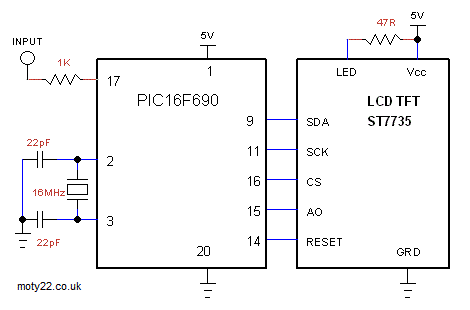 

TFT 16MHz FREQUENCY COUNTER PIC16F876A
LCD TFT is digital display at its best, it displays versatile clear picture. The picture is built by entering the address and the color of a pixel or rectangle, so it's simple to use too.
The TFT is driven by hardware SPI.
The LCD TFT module is a 1.8" 128 X160 pixel and has the driver ST7735
The frequency is displayed by 8 digits with leading zeros removed down to 3 digits. The picture displayed is based on 7 segment. The period is calculated. When input frequency is less than 1000Hz the period is displayed in us.
The counting is over a period of 1 second, generated by the 8 MHz crystal oscillator. The max counting is 8 digits
(16MHz). Period of 1 sec is generated by TMR1 and CCP1.
After programming the PIC16F876A connect pin 1 (reset) to 5V.
Code is for MPLABX and compiler XC8 (ver1.45).
 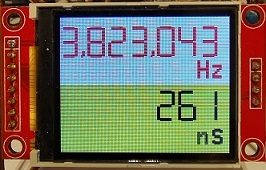
|
![]()
moty22.co.uk 2008-2024